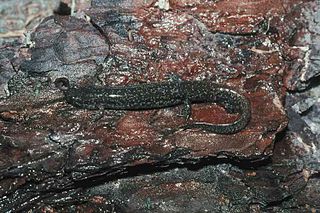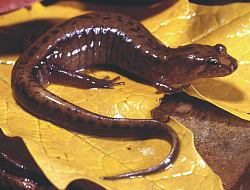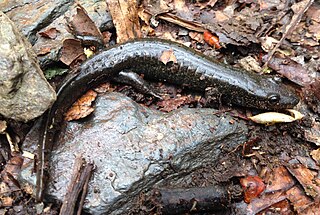 W
WDesmognathus is a genus of lungless salamanders in the family Plethodontidae known as dusky salamanders. They range from Texas to the eastern United States and to south-eastern Canada.
 W
WThe Allegheny Mountain dusky salamander is a species in the Plethodontidae family. It is found in the eastern United States, in the Niagara Glen Nature Reserve adjacent to the lower Niagara River in southern Ontario, and in southern Quebec, Canada. Its natural habitats are temperate forests, rivers, intermittent rivers, freshwater springs, and rocky areas.
 W
WThe Apalachicola dusky salamander is a species of salamander in the family Plethodontidae. It is threatened by habitat loss.
 W
WThe Apalachicola dusky salamander is a species of salamander in the family Plethodontidae. It is threatened by habitat loss.
 W
WThe southern dusky salamander is a species of salamander native to the coastal regions of the southeastern United States, from Virginia to Texas. Older sources often refer to it as the eared triton.
 W
WThe blackbelly salamander is a species of salamander in the family Plethodontidae. It is endemic to the United States. Its natural habitats are rivers, intermittent rivers, and freshwater springs. It is threatened by habitat loss.
 W
WThe Ouachita dusky salamander is a species of salamander in the family Plethodontidae. It is endemic to the states of Arkansas and Oklahoma in the United States. The specific epithet is in honor of Herbert Hutchinson Brimley and his younger brother, Clement Samuel Brimley, both of whom were zoologists.
 W
WDesmognathus fuscus is a species of amphibian in the family Plethodontidae. The species is commonly called the dusky salamander or northern dusky salamander to distinguish it from populations in the southern United States which form a separate species, the southern dusky salamander. The northern dusky salamander is the most widespread representative of its genus in Canada. It can be found in eastern North America from extreme eastern Canada in New Brunswick south into the panhandle of Florida and west to Louisiana. The size of the species' total population is unknown, but is assumed to easily exceed 100,000. The species' habitat differs somewhat geographically; dusky salamanders in the northern part of the range prefer rocky woodland streams, seepages, and springs, while those in the south favor floodplains, sloughs, and muddy places along upland streams. They are most common where water is running or trickling. They hide under various objects, such as leaves or rocks, either in or near water. Alternatively, they may enter burrows for protection. The dusky salamander lays its eggs close to water under moss or rocks, in logs, or in stream-bank cavities. The larval stage which follows is normally aquatic.
 W
WThe imitator salamander is a species of salamander in the family Plethodontidae. It is endemic to the Appalachian Mountains in the Eastern United States.
 W
WThe seal salamander is a species of lungless salamander that is endemic to the Eastern United States.
 W
WDesmognathus fuscus is a species of amphibian in the family Plethodontidae. The species is commonly called the dusky salamander or northern dusky salamander to distinguish it from populations in the southern United States which form a separate species, the southern dusky salamander. The northern dusky salamander is the most widespread representative of its genus in Canada. It can be found in eastern North America from extreme eastern Canada in New Brunswick south into the panhandle of Florida and west to Louisiana. The size of the species' total population is unknown, but is assumed to easily exceed 100,000. The species' habitat differs somewhat geographically; dusky salamanders in the northern part of the range prefer rocky woodland streams, seepages, and springs, while those in the south favor floodplains, sloughs, and muddy places along upland streams. They are most common where water is running or trickling. They hide under various objects, such as leaves or rocks, either in or near water. Alternatively, they may enter burrows for protection. The dusky salamander lays its eggs close to water under moss or rocks, in logs, or in stream-bank cavities. The larval stage which follows is normally aquatic.
 W
WThe Allegheny Mountain dusky salamander is a species in the Plethodontidae family. It is found in the eastern United States, in the Niagara Glen Nature Reserve adjacent to the lower Niagara River in southern Ontario, and in southern Quebec, Canada. Its natural habitats are temperate forests, rivers, intermittent rivers, freshwater springs, and rocky areas.
 W
WThe Ouachita dusky salamander is a species of salamander in the family Plethodontidae. It is endemic to the states of Arkansas and Oklahoma in the United States. The specific epithet is in honor of Herbert Hutchinson Brimley and his younger brother, Clement Samuel Brimley, both of whom were zoologists.
 W
WThe pygmy salamander is a species of salamander in the family Plethodontidae. It is endemic to the United States in the southern Appalachians in North Carolina and Tennessee.
 W
WThe seal salamander is a species of lungless salamander that is endemic to the Eastern United States.
 W
WThe seepage salamander is a small, terrestrial species of salamander in the family Plethodontidae. It is endemic to the United States. They are found in small areas of Tennessee, North Carolina, Georgia, and Alabama. Its natural habitats are temperate forests, intermittent rivers, and freshwater springs. It gets its name from the seepages around which it lives. It is very similar in its appearance and life history to the pygmy salamander. These two species differ greatly from the other Desmognathus species. They are the smallest salamanders in the genus, measuring only 3–5 cm (1–2 in) in length. They are also the only two terrestrial, direct-developing Desmognathus species. However, the two species are not often seen to coexist, differing in distribution by elevation; although there are exceptions. The seepage salamander is currently listed as Near Threatened, with its numbers declining in most of states in which it is found. It is threatened by habitat loss, with logging having a major effect.
 W
WThe southern dusky salamander is a species of salamander native to the coastal regions of the southeastern United States, from Virginia to Texas. Older sources often refer to it as the eared triton.